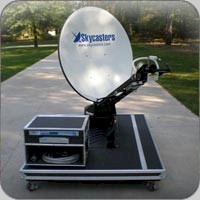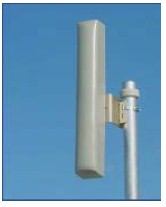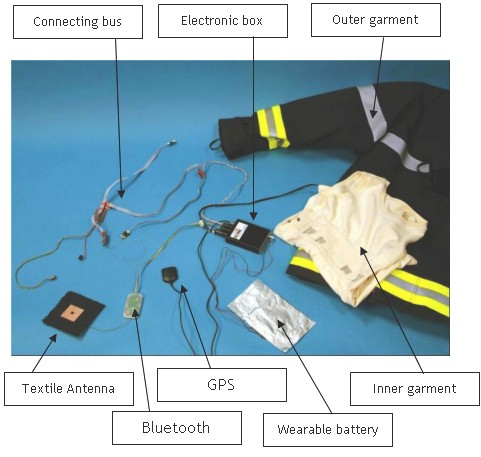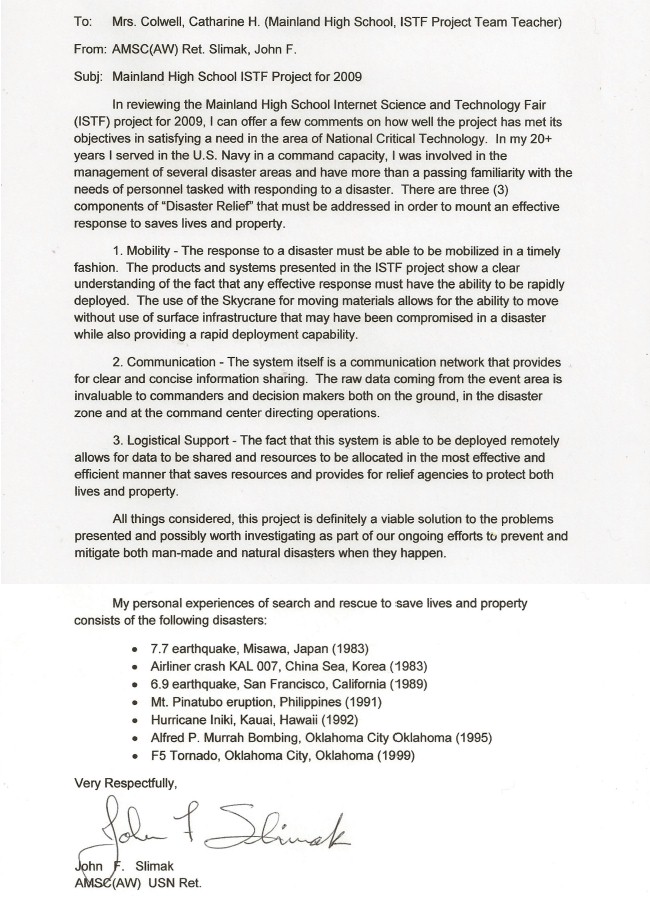|
Mainland High School
Suitable for a Disaster: ISTF 08-1835 |
||||||||||||||||||||
|
Home
Introduction Contest Components One Two  Product Product
Three Fabrics History of Fabrics Smart Fabric Projects Sensors Nano Sensors Power Production Communication Cell Phones 3G Phones Data Transfer Helikites Interoperability Microwaves Relief Agencies Telecommunication Project Assessment Team |
Component Two
Identify two companies and one product produced by each company that directly relate
to the NCT technical application your team has selected.
 Skycasters
is a satellite IP communications company based in Akron, Ohio, which was started
in 2001. They provide their services
to commercial, government, non-profit, and educational customers throughout North
and Central America. The company
promises that
Skycasters
is a satellite IP communications company based in Akron, Ohio, which was started
in 2001. They provide their services
to commercial, government, non-profit, and educational customers throughout North
and Central America. The company
promises that
Unlike other satellite communications providers, everything in our infrastructure
— from our teleports and hubs to the network operating center — is business-grade
and owned by Skycasters. With Skycasters as your primary or backup satellite Internet
connection, you can always count on low-latency data transmission.
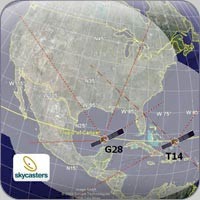 After a disaster strikes,
a previously "connected area" might suddenly be better classified as a "remote
site." Skycasters provides solutions to connectivity shortages. Instead of
investing thousands of dollars in laying cable to a location, direct satellite communication
is a much more reasonable solution. Skycasters has access to
two geosynchronous satellites that provide coverage for the majority of North
America.
After a disaster strikes,
a previously "connected area" might suddenly be better classified as a "remote
site." Skycasters provides solutions to connectivity shortages. Instead of
investing thousands of dollars in laying cable to a location, direct satellite communication
is a much more reasonable solution. Skycasters has access to
two geosynchronous satellites that provide coverage for the majority of North
America.
In emails dated 24 February, 2009, Skycaster President, Mike Kister wrote: For our project, he recommended a trailer solution that includes a 4-watt BUC transmitter, their 7000 controller and a 1.2 meter antenna (portable generator). The solution would cost $30,945. In addition, we would require a service plan that fit the needs of the disaster's scope. Mr. Kister added that the satellite relay (backhaul) is independent of the network/type of data being backhauled. There can be a secure phone network (and it's associated equipment), a public phone system (and it's associated equipment), a Wi-Fi network, a Wi-Max Network, and a LAN, all plugged into a single satellite backhaul... and it will all work just fine (assuming sufficient capacity)
Although the British company ProeTEX
does not currently have any products for sale, they have released their first smart
textile prototype. Professor Annalisa Bonfiglio, who works in the Department of
Electrical and Electronic Engineering at the University of Cagliara, Italy, is their
principal investigator. Their research is in conjunction with the Smart Fabrics and Interactive Textiles (SFIT)
cluster. ProeTEX, started in February 2006, will receive funding (8.1
million euros) for 48 months through the
Information Society Technologies (IST).
ProeTEX is focusing on merging
micro- and nanotechnologies within a communications network to improve the safety of emergency
workers, firefighters, and civilian victims. They are hoping that their developments
will eventually translate into a wide range of other markets: including, extreme
sports and healthcare for maintenance and construction workers.
Their first prototype for Project FP6-2004-IST-4-026987 has these primary components: an inner garment, outer garment, electronics, and communication software.
Identify one professional association or trade organization associated with the
products your team identified.
Include:  its name, its name,
 description of its mission, and description of its mission, and
 number of people/companies involved. number of people/companies involved.
The Institute
of Electrical and Electronic Engineers Incorporated (IEEE) is one of the
premier affiliations working on the development of technological progression. The
range of this organization includes the study of telecommunications, consumer electronics,
and electronic materials. IEEE spreads throughout more than 160 countries and consists
of more than 370,000 members, of which over 80,000 are students.
Since our smart suit's sensors and their functionality are vital to our product's
success, we have included an additional organization that focuses entirely on the
research and development of smart textiles.
The Materials
Research Society "is an organization of materials, researchers from academia,
industry, and government that promotes communication for the advancement of interdisciplinary
materials research to improve the quality of life." They were founded in 1973 and
currently consist of 15,100 members from 71 countries around the world. MRS works
towards maintaining a diverse group of cooperative and dedicated members. They provide
high quality meetings that work towards communication
in the fields of research and technology. Since MRS is a communication bound organization,
they work hard to spread information in these fields to the multiple governments
as well as the public. They usually sponsor two meetings a year consisting of around
35 symposia each.
At their Spring Meeting in 2006, which was held in San Francisco, CA, one of the symposium covered the topic of "smart nanotextiles." They addressed the possibility of future garments that do more than just keep you warm. They could perform multiple functions including monitoring your body functions, dressing wounds, and protecting from environmental conditions. Speakers at the conference included such eminent researchers as: Ray Baughman, Danilo De Rossi, Ben Mattes, Eckhard Schollmeyer, Mohan Srinivasarao, and Gordon Wallace. At their Fall 2008 Conference, in Boston, MA, they held sessions on nano- and microscale materials under extreme environments (EE) and polymer-based smart materials (BB).
Propose and describe a new product or new process based on your team's NCT technical
application.
Our product is a fully interoperable communication system
to support recovery operations in the aftermath of a disaster. The system consists
of several components with the primary units being a 'smart suit,' a WiMax network
based in a mobile base with a temporary 'tower' and a satellite ISP with attendant
hardware and software.
Via the Internet, locate a company that might be able to manufacture your team's
proposed product. Send the company an e-mail asking that someone in the company
evaluate the product your team proposed. If your team is not able to obtain a response
to your inquiry, provide on your website an example of the e-mail request you sent
and the names of manufacturers to whom you sent the request.
ProeTEX - Project FP6-2004-IST-4-026987 http://www.proetex.org/ ProeTEX - Objectives http://www.proetex.org/objectives.htm ProeTEX - First Prototypes http://www.proetex.org/first_prototypes.htm ProeTEX - Inner Garment http://www.proetex.org/p1_inner_garment.htm ProeTEX - Outer Garment http://www.proetex.org/p1_outer_garment.htm ProeTEX - Electronics http://www.proetex.org/p1_electronics.htm ProeTEX - Communication Software http://www.proetex.org/P1_software.htm About IEEE http://www.ieee.org/web/aboutus/home/index.html The Open Group San Diego 2009 http://www.opengroup.org/sandiego2009/ The Open Group Making Stadards Work http://www.opengroup.org/ TOGAF http://www.opengroup.org/press/17dec08.htm Skycasters - Remote Business http://www.skycasters.com/remote-business/index.html Skycasters http://www.skycasters.com/ Skycasters - Disaster Response http://www.skycasters.com/disaster-recovery/index.html CSEM - objectives http://www.csem.ch/sfit/ ISTweb - IST Project Fact Sheet http://cordis.europa.eu/ ISTweb - About IST http://cordis.europa.eu/ist/about/about.htm Tranzeo - Communicate Without Boundaries http://www.tranzeo.com/profile.php Tranzeo - Vertical Sector Antenna http://www.tranzeo.com//products/docs/TR-58V-60-17.pdf Tranzeo - 5 GHz Sectors http://www.tranzeo.com/products/antennas/5-GHz-Sectors Redline Communication - Company Profile http://www.redlinecommunications.com/about_us/profile.html Redline Communications - RedConnex AN-50e http://www.redlinecommunications.com/products/RedCONNEX_AN50e.html Skycasters - The Satellites http://www.skycasters.com/broadband-satellite-internet-fleet/the-satellites.html Skycasters - Disaster Response http://www.skycasters.com/disaster-recovery/index.html Skycasters - Service Plans for Disaster Response Teams http://www.skycasters.com/disaster-recovery/service-plans.html |
|||||||||||||||||||
